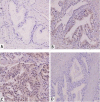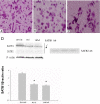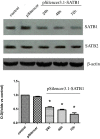SATB1 is overexpressed in metastatic prostate cancer and promotes prostate cancer cell growth and invasion
- PMID: 23642278
- PMCID: PMC3651708
- DOI: 10.1186/1479-5876-11-111
SATB1 is overexpressed in metastatic prostate cancer and promotes prostate cancer cell growth and invasion
Abstract
Background: Special AT-rich sequence binding protein 1 (SATB1) is a nuclear factor that functions as the global chromatin organizer to regulate chromatin structure and gene expression gene expression. SATB1 has been shown to be abnormally expressed in various types of cancer. However, the expression and role of SATB1 in prostate cancer remain unclear.
Methods: 120 cases of prostatic carcinoma and 60 cases of benign prostate hyperplasia were analyzed for SATB1 expression by immunohistochemistry. LNCaP, DU-145, and PC3 prostate cancer cells were examined for SATB1 expression by Western blot analysis. Cell proliferation and invasion was evaluated by CCK8 and transwell invasion assay, respectively.
Results: SATB1 staining was stronger in prostatic carcinomas with metastasis than in those without metastasis, but was absent in benign prostate hyperplasia. Furthermore, SATB1 expression was positively correlated with bone metastasis and the Gleason score. SATB1 overexpression promoted the proliferation and invasion of LNCaP cells while SATB1 knockdown inhibited the proliferation and invasion of DU-145 cells.
Conclusions: These findings provide novel insight into oncogenic role of SATB1 in prostate cancer, suggesting that SATB1 is a promising biomarker and therapeutic target for prostate cancer.
Figures






Similar articles
-
SATB1 promotes prostate cancer metastasis by the regulation of epithelial-mesenchymal transition.Biomed Pharmacother. 2016 Apr;79:1-8. doi: 10.1016/j.biopha.2016.01.038. Epub 2016 Feb 9. Biomed Pharmacother. 2016. PMID: 27044805
-
Upregulation of SATB1 is associated with prostate cancer aggressiveness and disease progression.PLoS One. 2013;8(1):e53527. doi: 10.1371/journal.pone.0053527. Epub 2013 Jan 7. PLoS One. 2013. PMID: 23308245 Free PMC article.
-
SATB1 Promotes Pancreatic Cancer Growth and Invasion Depending on MYC Activation.Dig Dis Sci. 2015 Nov;60(11):3304-17. doi: 10.1007/s10620-015-3759-9. Epub 2015 Jun 25. Dig Dis Sci. 2015. PMID: 26108419 Free PMC article.
-
Chromatin organizer SATB1 as a novel molecular target for cancer therapy.Curr Drug Targets. 2012 Dec;13(13):1603-15. doi: 10.2174/138945012803530008. Curr Drug Targets. 2012. PMID: 22998183 Review.
-
SATB1 is a Novel Molecular Target for Cancer Therapy.Cancer Invest. 2018 Jan 2;36(1):28-36. doi: 10.1080/07357907.2018.1423688. Epub 2018 Jan 30. Cancer Invest. 2018. PMID: 29381393 Review.
Cited by
-
SATB1 is a potential therapeutic target in intrahepatic cholangiocarcinoma.Clin Transl Oncol. 2016 Sep;18(9):878-83. doi: 10.1007/s12094-015-1449-x. Epub 2015 Nov 13. Clin Transl Oncol. 2016. PMID: 26563145
-
Special AT-rich DNA-binding protein-1 expression is associated with liver cancer metastasis.Oncol Lett. 2016 Dec;12(6):4377-4384. doi: 10.3892/ol.2016.5281. Epub 2016 Oct 18. Oncol Lett. 2016. PMID: 28101200 Free PMC article.
-
Inhibition of prostate cancer cell growth in vivo with short hairpin RNA targeting SATB1.Oncol Lett. 2017 Dec;14(6):6592-6596. doi: 10.3892/ol.2017.7006. Epub 2017 Sep 20. Oncol Lett. 2017. PMID: 29151908 Free PMC article.
-
Adaptive and non-adaptive gene expression responses in prostate cancer during androgen deprivation.PLoS One. 2023 Feb 21;18(2):e0281645. doi: 10.1371/journal.pone.0281645. eCollection 2023. PLoS One. 2023. PMID: 36809527 Free PMC article.
-
3D Genome Organization as an Epigenetic Determinant of Transcription Regulation in T Cells.Front Immunol. 2022 Jun 22;13:921375. doi: 10.3389/fimmu.2022.921375. eCollection 2022. Front Immunol. 2022. PMID: 35812421 Free PMC article. Review.
References
-
- Raheem O, Kulidjian AA, Wu C, Jeong YB, Yamaguchi T, Smith KM, Goff D, Leu H, Morris SR, Cacalano NA, Masuda K, Jamieson CH, Kane CJ, Jamieson CA. A novel patient-derived intra-femoral xenograft model of bone metastatic prostate cancer that recapitulates mixed osteolytic and osteoblastic lesions. J Transl Med. 2011;9:185. doi: 10.1186/1479-5876-9-185. - DOI - PMC - PubMed
Publication types
MeSH terms
Substances
LinkOut - more resources
Full Text Sources
Other Literature Sources
Medical
Research Materials

